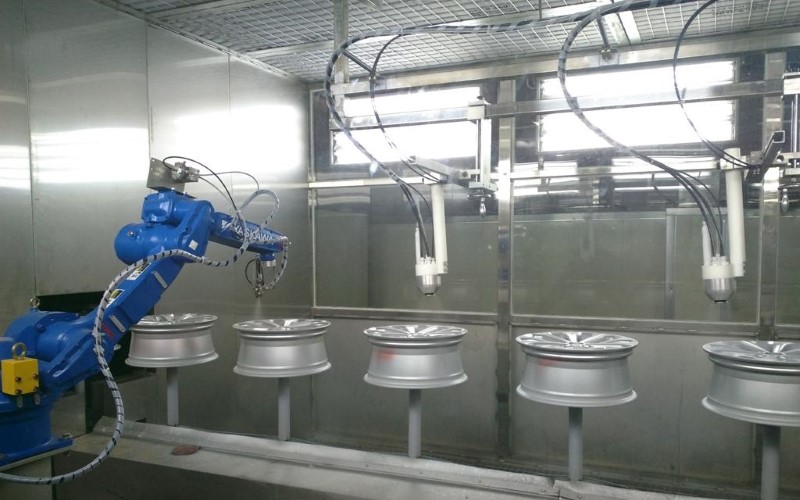What is powder coating?
Powder coating is a dry finishing process used to apply a protective and decorative coating to a wide range of materials, most commonly metal. It involves applying a fine powder, typically made of pigments, resins, and additives, onto the surface of an object. The powder is electrostatically charged, which causes it to adhere to the grounded object. The coated object is then heated in a curing oven, where the powder particles melt, flow, and fuse together, forming a continuous and durable coating.
The powder coating process offers several advantages over traditional liquid coatings. It provides a uniform and consistent finish, with excellent color retention and resistance to chipping, scratching, and fading. Powder coatings are also environmentally friendly as they contain no solvents and release negligible amounts of volatile organic compounds (VOCs) into the atmosphere. Additionally, the powder coating process allows for a wide variety of colors, textures, and finishes to be achieved, making it highly versatile for both functional and decorative applications.
Powder coating is commonly used in industries such as automotive, architecture, furniture, appliances, and many others, where a durable and high-quality finish is desired. It provides an attractive appearance, protects against corrosion, and enhances the overall durability and lifespan of the coated objects.
How does powder coating work?
Powder coating is a multi-step process that involves the application of dry powder onto a surface and subsequent curing to form a protective and decorative coating. Here is a step-by-step explanation of how powder coating works:
1. Surface Preparation: The surface to be coated is first cleaned and prepared to ensure proper adhesion of the powder. This typically involves removing dirt, grease, rust, and old paint through processes like degreasing, sandblasting, or chemical cleaning.
2. Powder Application: Once the surface is prepared, the powder coating material is applied. The powder consists of finely ground particles made of pigments, resins, fillers, and additives. There are different methods of powder application:
- Electrostatic Spray: The most common method involves using an electrostatic spray gun. The gun imparts an electrostatic charge to the powder particles as they are sprayed. The charged particles are attracted to the grounded object, evenly coating its surface.
- Fluidized Bed: In this method, the object is preheated and dipped into a bed of fluidized powder particles. The heat causes the powder to melt and adhere to the surface, forming a coating.
3. Powder Adhesion: The charged powder particles are attracted to the grounded object due to electrostatic forces. The powder particles wrap around the object, adhering to its surface.
4. Curing: After the powder is applied, the object is transferred to a curing oven. The curing process involves heating the coated object to a specific temperature, typically between 150 to 200 degrees Celsius (300 to 400 degrees Fahrenheit). At this temperature, the powder particles melt and flow together, forming a continuous film. The curing time can vary but is usually around 10 to 30 minutes, depending on the powder formulation and object size.
5. Cooling and Finalization: After the curing process, the object is allowed to cool down. As it cools, the melted powder solidifies, forming a hard and durable coating. Once cooled, the coated object is ready for use or further processing.
The result of the powder coating process is a tough and attractive finish that provides excellent protection against corrosion, chemicals, and mechanical damage. Powder coatings are known for their durability, resistance to chipping, scratching, and fading, making them suitable for a wide range of applications in various industries.
The benefits and limitations of powder coating
Powder coating offers several benefits and advantages compared to other coating methods. However, it also has some limitations. Let's explore both aspects:
Benefits of Powder Coating:
1. Durability: Powder coatings are highly durable and resistant to chipping, scratching, and fading. They provide a tough and long-lasting finish that can withstand harsh environmental conditions, making them ideal for outdoor applications.
2. Excellent Protection: Powder coatings offer excellent protection against corrosion, chemicals, UV rays, and abrasion. They act as a barrier, shielding the substrate from damage and extending the lifespan of the coated object.
3. Attractive Finish: Powder coatings provide a smooth, even, and high-quality finish with a wide range of colors, gloss levels, and textures available. They can achieve various decorative effects and can be customized to meet specific aesthetic requirements.
4. Environmentally Friendly: Powder coatings are environmentally friendly compared to liquid coatings. They contain no solvents or VOCs, minimizing air pollution and reducing health risks. Powder overspray can also be collected and reused, minimizing waste.
5. Cost Efficiency: Although the initial setup costs for powder coating may be higher compared to liquid coatings, it offers long-term cost savings. Powder coatings have high transfer efficiency, require less material, and have minimal waste, reducing material and disposal costs over time.
Limitations of Powder Coating:
1. Thin Coatings: Powder coatings are generally thicker than liquid coatings, making it challenging to achieve very thin coatings. If a thin coating is required, special techniques may be needed.
2. Heat Sensitivity: The curing process of powder coating involves heating the object in an oven. This limits the use of powder coating on heat-sensitive materials that cannot withstand high temperatures.
3. Complex Shapes: Powder coating may be difficult to apply uniformly on complex or intricate shapes with recesses, corners, or tight spaces. The Faraday cage effect can occur, resulting in uneven coverage or difficulty reaching recessed areas.
4. Color Matching: Achieving precise color matching with powder coating can be challenging. Variations in pigment batches and different curing conditions may result in slight color variations between batches.
5. Limited Repairs: Unlike liquid coatings that can be easily touched up or repaired, powder coatings are more challenging to repair once damaged. Entire sections or objects may need to be recoated for consistency.
Despite these limitations, powder coating remains a popular and widely used coating method due to its many advantages in terms of durability, protection, aesthetics, and environmental sustainability.


